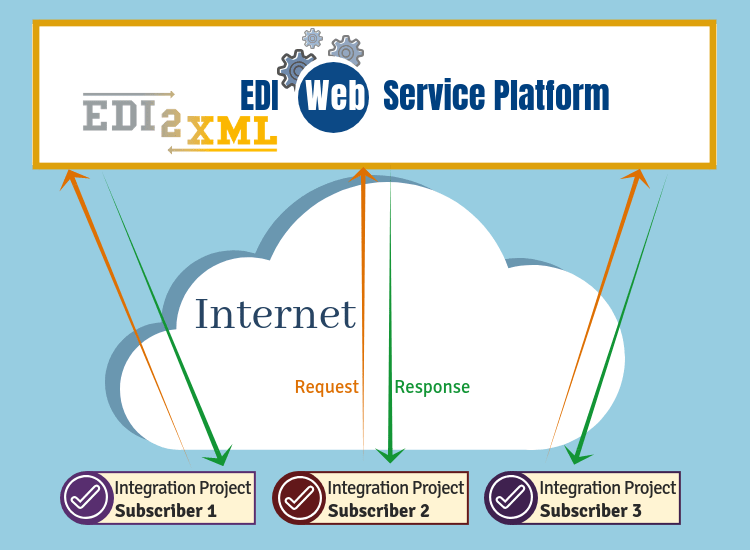Today, there are still decision-makers who are debating whether to invest in EDI integration projects or to hire a few new employees to manually enter and process data from trading partners.
Since EDI is still a difficult topic for non-technical people to understand, hiring data entry administrators may seem like a reasonable choice. It is commonly believed that EDI requires a significant initial investment.
Let’s take a look at what EDI automation is and how companies can find the most cost-effective solution.
What is EDI Automation?
EDI (electronic data interchange) is a technology used by business partners to exchange business electronic documents in standard formats without requiring human intervention.
These exchanged documents are called – EDI Transaction Set. If you want to see the full list of documents that can be exchanged in EDI format check our Complete List of EDI X12 Codes.
How Does EDI Benefit Businesses?
The use of EDI greatly improves the overall state of the business as it has many benefits.
– Reducing costs. Saving time for employees to process documents and enter them into databases. EDI reduces an enterprise’s printing, shipping, and storage costs.
– Speed. Documents can be exchanged instantly with a business partner. You won’t lose documents along the way or among the papers on your desk.
– Automation. EDI significantly improves the business because it automates processes and reduces the time delays associated with manual data entry.
– Accuracy. Elimination of errors associated with manual data entry.
Useful: Download our free Guide “Introduction to EDI Communication” to learn more about EDI
What Documents are Used in EDI?
As mentioned above, you can exchange almost any type of document using EDI, but the most common ones are:
Purchase Order – EDI 850
Useful Reading: All You Need to Know About EDI ANSI X12 Transaction Set 850 Purchase Order
Invoice – EDI 810
Useful Reading: What is an ANSI ASC X12 EDI 810 Invoice?
Purchase Order Acknowledgment – EDI 855
Useful Reading: What is EDI 855 Purchase Order Acknowledgment?
Inventory Inquiry/Advice – EDI 846
Useful Reading: What is EDI 846 document?
Advanced Ship Notice (ASN)– EDI 856
Useful Reading: What is Advanced Ship Notice (ASN) 856 Transaction Set?
Below is an example of an EDI flow between trading partners.
Types of EDI (Electronic Data Interchange) Solutions
Currently, many EDI providers offer various EDI solutions. There is no one-size-fits-all EDI solution for every company. A company should evaluate which option will be most cost-effective for its business model. Thus, the main offers on the EDI market are:
Our company offers all three named EDI solutions. If you don’t know which solution is right for you, contact our experts for a free consultation.
EDI Document Business Flow
1. One business partner (generally the buyer) generates a document (i.e. Purchase Order) in his internal ERP system (i.e. SAP, Microsoft Dynamics, JD Edwards, etc.). Depending on the company’s business process, the document can be generated automatically or manually.
2. EDI providers can either pick up the generated document directly from the company’s ERP system, or they can transfer it to them.
3. The EDI provider converts the document into an X12 EDI transaction set. After conversion, suppliers receive an EDI X12 document.
What is the Fastest Way to Connect to EDI?
With EDI2XML and its “HTTP EDI Web Service (REST API)” model, companies can connect their EDI partners in less than one hour! EDI web services reduce the cost of EDI integration projects and improve efficiency and accuracy in a short amount of time.
As a result of using the EDI Web Service from EDI2XML, a company can quickly and efficiently exchange business documents with its business partner.
Learn more about EDI2XML Web Service its advantages and how it works.
Request EDI2XML Web Service Price List






















 RosettaNet is a non-profit organization having more than 500 high-tech companies as members. These members create and implement open standards for processing business to business (B2B) transactions, especially at the supply chain level, in their appropriate vertical. The main mission of RosettaNet organization is to generate standard protocols for specific business transactions such as new Product Information, order Management, design registration, request technical data, etc.
RosettaNet is a non-profit organization having more than 500 high-tech companies as members. These members create and implement open standards for processing business to business (B2B) transactions, especially at the supply chain level, in their appropriate vertical. The main mission of RosettaNet organization is to generate standard protocols for specific business transactions such as new Product Information, order Management, design registration, request technical data, etc. RosettaNet optimizes existing standards, guidelines, and specifications of open e-business for cross-platform applications and network communications. RosettaNet defines the concepts of e-business (file formats, procedures, implementation, requirements, etc.) and develops standards for ensuring compatibility of business processes. RosettaNet is based on open XML standards.
RosettaNet optimizes existing standards, guidelines, and specifications of open e-business for cross-platform applications and network communications. RosettaNet defines the concepts of e-business (file formats, procedures, implementation, requirements, etc.) and develops standards for ensuring compatibility of business processes. RosettaNet is based on open XML standards.







